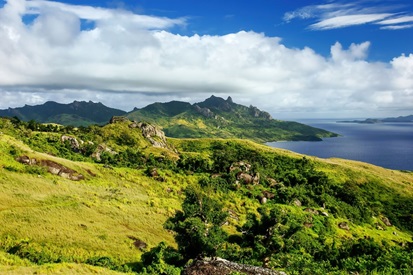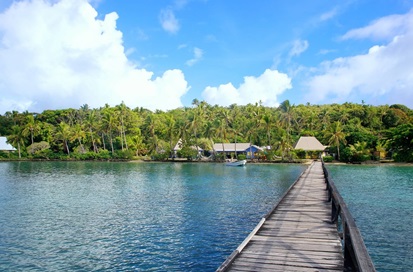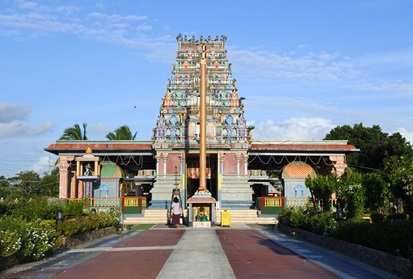

Fijian cuisine is a mixture of diverse influences that are reflected in its rich flavors and aroma. It combines traditional Fijian dishes with elements of Indian, Chinese, Tongan and Melanesian cuisine to create a unique and exotic taste!
Fiji is an island country located off Oceania, in the South Pacific Ocean. The country is surrounded by Vanuatu, New Caledonia, Wallis Futuna, Samoa, Tonga, Tuvalu, Kermadec Island and New Zealand. This arrangement, of course, made its own adjustments to the kitchen.
The country's population mainly consists of representatives of different nationalities, including Melanesians (54.3%), Indo-Fijians (38.1%), Rotumans (1.2%) and others. Fijian cuisine is undoubtedly a reflection of the country's diversity and offers many unique delicacies that are worth trying.
Fiji's culture has been heavily influenced by Indian cuisine, as many Indian immigrants came to the islands in the 19th and 20th centuries to work on plantations. Hence the appearance of curry dishes, roti and dal. With the arrival of European and Asian colonizers in Fiji, new ingredients and cooking techniques appeared in the kitchen. Rice, potatoes, wheat and various spices were brought to the islands and became an integral part of Fijian cuisine. However, despite the influence of other cultures, Fijian cuisine has retained its uniqueness and authenticity

Depositphotos
Features of Fiji cuisine
There are currently two main cultures represented in Fiji: Fijians and Indo-Fijians. Both cultures have their own specialties, and a mixture of fusion dishes.
As an ocean country, it's no surprise that seafood makes up a large part of Fiji's culinary world. But modern Fiji is a diverse society with a noticeable Asian influence, where you can find the best curry of your life.
Fijian food
Like its neighbors in the South Pacific, Fijian food traditionally consists of a few basic ingredients that are readily available in the archipelago. Rice, sweet potatoes, taro (a tropical root vegetable), coconuts, cassava (a starchy shrub), breadfruit and, of course, fish have formed a large part of the Fijian diet for centuries.
Sea shrimp, mussels, clams, sea urchins, sea cucumbers, oysters, lobsters, fish, crabs, octopus and squid are the main sources of protein in most popular dishes. After all, Fiji is an ocean country.
Traditional recipes have been passed down from generation to generation, and many dishes have remained unchanged for centuries. Local dishes include roti and curry, boiled taro and fish soup, and butter crackers. Meat, including chicken and lamb, is widely consumed, while beef and pork are used for special celebrations. Fiji produces its own coffee, beer and rum. Fijian supermarkets sell imports from New Zealand and Australia, supplying Western food products. Indian and Chinese supermarkets are available for purchasing oriental products. The country's history as part of the British Empire has also deeply influenced many of the country's culinary styles.

Depositphotos
Indo-Fijian cuisine
The islands of Viti Levu and Vanua Levu have many curry houses where you will find delicious, affordable and authentic food. There are several Indian and Fijian dishes worth trying, including baigan valo - eggplant stuffed with fish, spicy sauce and coated in coconut cream. Also, a favorite among Indo-Fijians is roti, an Indian flatbread.

Depositphotos
Chinese cuisine
Fiji also has a small but influential Chinese population, as evidenced by a number of popular Chinese restaurants in city centers.
Street food in Fiji
Nadi Market is a fairly quiet place where local products are sold without fuss and you can do a little haggling. Fish, taro, bananas, pineapples, sugar cane and kava are sold in abundance. If you buy food from Nadi market to cook it yourself, it is better not to take peeled fruits and fish - the market does not have a freezer, so the freshness of the food is not guaranteed.
.jpg)
Depositphotos
Local food in Fiji
Local food is not ideal, food poisoning can happen. Hotel buffets may be open, making food vulnerable to bacteria. At buffets, eat only fresh and well-prepared food.
Avoid hot foods that have become cold and cold foods that have become warm. Be careful when eating shellfish.
Make sure you use serving utensils that are kept clean and dry. Ask that there are no ice cubes in your drink, as these may be made from poor quality water. Despite some unfortunate incidents of sick travelers, most resorts in Fiji are committed to delivering the best possible service.

Depositphotos
Food in the villages
Some villagers may invite you to join their table. And although by all standards of hospitality you cannot refuse, pay close attention to the quality of the food served before you try it.
It's easier to spend your holiday in Fiji by choosing Western dishes offered by many of the country's resort restaurants. At the same time, exploring traditional and modern Fijian cuisine can be a surprising and enjoyable culinary experience.

Depositphotos
Fijian drink kava: etiquette and safety
The national drink of Fiji is kava, otherwise known as yaqona. Cava is made from yaqona root (a relative of pepper), which is crushed and strained with water in a large wooden bowl. The drink is famous for its analgesic effect. Fijians drink it as tea, and Pacific Islanders have been using it for hundreds of years. Kava is believed to act on the brain similar to alcohol, making a person feel calm and relaxed. But kava is also believed to have health benefits, such as relieving pain, preventing cramps and relaxing muscles.
Preparing and drinking kava is an ancient tradition. And it is a must when visiting a Fijian village for the first time.
A traditional kava ceremony can be one of the most memorable experiences of your trip to Fiji, but there are some etiquette and safety rules to keep in mind. The kava ceremony is traditionally performed for tourists visiting Fijian villages. And guests are often expected to bring kava root as a gift to the villages, which can be bought at local markets.
Kava ceremonies are an ancient tradition that follows a strict structure and etiquette. It is carried out when two groups of people meet. If you are joining a kava ceremony, remember:
- During the ceremony, everyone sits in their seats.
- Men and women are expected to dress modestly; women usually wear a sarong.
- The oldest man in the group enters first, followed by the rest of the men and women.
- The eldest male in your group is considered the chief and is expected to present your offering of kava and drink first.
- Men drink first, then women.
The ceremonies are accompanied by singing and dancing as the two groups come together. After this, visitors are free to explore the village.
The safety of kava is a controversial issue. There have been recent reports that products labeled as kava can cause serious liver problems and even death. But the general consensus is that kava is safe for adults in moderation. Kava is also considered a delicacy in Tonga, Hawaii, Micronesia, Samoa and Vanuatu.

Depositphotos
Main dishes of Fiji
Kokoda
This is a staple at any resort restaurant that has access to fresh mahi mahi fish (also known as dorado fish). A delicacy of raw fish marinated in coconut cream, onions, tomatoes and lime. Make sure the fish is fresh and hygienically prepared. Otherwise, you can be seriously poisoned, even to the point of hospitalization. The dish also includes chili peppers, onions, tomatoes, green onions, capsicums and sea water
Kokoda is served in a large shell, coconut shell or bamboo. Kokoda is said to be similar to Peruvian ceviche and Hawaiian poke, except with the addition of coconut milk. Typically served as an appetizer, this dish is available in almost every restaurant in the country.

Depositphotos
Fish Suruwa
This is a traditional Fijian curry. It is made from fish cooked in coconut milk and Indian spices such as cumin, turmeric and garam masala. Onions, chillies and tomatoes are also added and served with white rice or Indian rotis. Curry plays an important role in Fijian cuisine. This dish was brought to the country by the Indian community, who originally came as sugar cane workers back in the 1870s. Suruva fish is widely consumed at weddings.
Nama
Nama, commonly known as sea grapes or green caviar. This is a seaweed that locals prefer to eat raw. However, they are also added to dishes as a side dish. Can be added to salad, coconut milk.
This dish has a salty taste and is rich in vitamin C and vitamin A. Unlike Fijians, people from other countries add it to stews. Nama are collected from many of the shallow reefs around the islands, mainly in the Yasawas. Seaweed grows in the shallow waters of the Yasawas Islands lagoon. You can even join the villagers for the harvest.
Palusami
A traditional Fijian delicacy made from taro leaves (also known as ruru) filled with a mixture of meat and coconut milk. It is cooked in lovo to achieve the most authentic taste.
Traditionally, corned beef was added to the palusami recipe, since fresh meat was difficult to find on the islands. However, seafood is now used as a substitute. Besides Fiji, palusami is common in other Pacific cuisines, including Samoa and Tuvalu.
Lovo
In Fiji, lovo means a feast prepared on earth. Lovo is Fiji's answer to barbecue. The traditional treat of fish, meat and vegetables wrapped in banana leaves is cooked in a makeshift underground oven dug into the ground, lined with coconut husks.Lovo is traditionally prepared to celebrate significant events in the village, such as a wedding or holiday. Today, most resorts organize regular celebrations with Lovo treats for their guests.
The dish is covered with mud and left to cook slowly for about three hours.
The dish has a special smoky flavor thanks to the leaves. Considered one of the most popular dishes in Fiji.

Depositphotos
Sapasui
Sapasui is sometimes called Samoan chop suey. This is a simple dish made with noodles, chicken, beef or pork.
Duruka
Known as “Fijian asparagus”, it is an unopened flower of a reed shoot. The plant is similar to sugar cane and is easily found throughout Southeast Asia and other Pacific Islands.
There are both red and green varieties of duruka in Fiji. Red duruka is harder than green one. Fijians add duruka to coconut milk or curry.

Depositphotos
Rourou
A delicacy made from taro or dal leaves stewed in coconut milk. The dish has a creamy consistency and looks like spinach. It is usually consumed as an appetizer or side dish, traditionally accompanied by boiled taro roots. Can be used to prepare Rourou Peti - rourou leaves stuffed with a mixture of chillies, onions, coconut milk and tuna.
Cassava cake
Cassava cake is a sweet, moist cake made from the cassava root vegetable. Coconut milk, condensed milk and custard are also added to the dish
Baigan Valo
Baigan Valo - Indian cuisine of Fiji. It is stuffed eggplant. Baingan means eggplant in Hindi and in Baigan Valo the eggplant is stuffed with fish or hot sauce and then coconut cream. You will find the dish on the menu of many resort and city restaurants!
Fijian Roti
The favorite food of Indo-Fijians is flatbread cooked on an iron tawa and served with curry. And often they wrap food in it in eateries.
Babakau
A real treat for breakfast - babakau - Fijian fried bread! While most resorts offer a standard continental breakfast, guesthouse hosts usually serve babakau! This delicious bread is usually served with jam, butter and fruit.
Fish
In Fiji you will try fish that you never knew existed before. The fish is fried, grilled, steamed, or smoked. By the way, Fijians do not filet fish, so be prepared for the fact that you will have to pick out the bones.
Tropical fruits
The best introduction to Fiji's national cuisine is a trip to the food market, where you can try all the exotic tropical fruits that you didn't even know existed! What fruit is Fiji famous for? Try smooth papaya, jelly-like Fijian longan and more! Even pineapples and bananas will look different and taste different. And, of course, this is the land of coconuts!

Depositphotos
Fiji Coffee
Coffee bean plantations are located in the inland mountainous regions of Fiji. Local coffee is roasted by several companies: Bula Coffee and Fiji Coffee are two popular brands that can be seen in cafes and sold in souvenir shops.
Coconut bread
It is a staple in the tropics. It can be found not only in Fiji, but also in the Pacific Islands. Try hot bread straight from the bakery in Nadi, Namaka, Denarau or Suva.
Sugar cane
Much of the land in Viti Levu and Vanua Levu is occupied by sugarcane plantations. It is not uncommon for trucks and trains carrying sugarcane to pass through towns and even some resorts! During the harvest season (November) you can find a lot of raw sugar cane. Resorts are happy to cut it up so guests can taste the raw treats! It is also used in the production of Fijian rum.

Depositphotos
Tips for tourists
- Tap water in urban areas is generally safe to drink in Fiji, as well as in resorts, which often have their own water filtration system. In villages and remote areas, the water may not be safe to drink. Even if locals drink it, they are usually used to it.
- If you are in areas with unsafe water, such as remote islands, avoid eating salads or raw foods. Try to eat food prepared in front of you. Vegetarian foods are generally safer than meat or fish.
- There are a number of restaurants on the islands of Viti Levu, Vanua Levu and Taveuni where you can try what the locals eat. Other island groups have resorts with their own restaurants. Local restaurants are quite inexpensive, especially curry houses and Chinese restaurants. But at the resorts the prices are steep.
- Use hand sanitizer. If you have intestinal disorders, go to the doctor immediately.
- Be careful when eating reef fish: if they have eaten toxic algae, it can cause ciguatera. Locals know which reef fish to avoid, so only eat what the locals eat or avoid them altogether.

Depositphotos
More articles
- Yogyakarta - all about the historic city of Java
- St. Anne Island in the Seychelles
- When to fly to Seychelles: prices and weather
- The best hotels in Kuta in Bali: 15 corners
- IHG Hotels & Resorts - 13 hotels in Bali
- Bali Retreat: Hotels and Deals
- The best excursions in the Seychelles - 11 ideas for impressions
- Which beach to choose in the Seychelles - 11 best
- Top 12 Bali Hotels for Wellness
- Top 10 Places to See in the Seychelles



